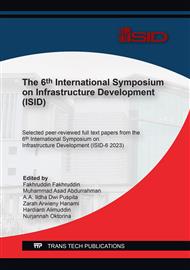p.41
p.47
p.57
p.69
p.81
p.93
p.103
p.115
p.123
Flexural Behavior of Hybrid Geopolymer Fly Ash Beams with Addition of PVA (Polyvinyl Alcohol) Fiber
Abstract:
Using cement as the primary material for making concrete, around 7%-15%, requires a significant amount of energy and generates abundant waste, thus significantly impacting the environmental conditions. Innovative materials are needed as alternatives to cement. Fly ash, as an environmentally friendly material, can be a solution to minimize the use of cement. The selected fiber is Poly-Vinyl Alcohol (PVA) fiber due to its high tensile strength, which can effectively inhibit the rate of crack development occurring in the beams. The research process was divided into two stages: geopolymer mortar compressive strength testing and beams flexural testing. Compressive strength testing of geopolymer mortar was conducted on 50x50x50 mm cube samples, tested at ages of 3, 7, and 28 days using both air curing and moist curing methods. Geopolymer mortar was created using fly ash as the base material, along with activators such as Sodium Hydroxide (NaOH) and Sodium Silicate (Na2SiO3). Meanwhile, flexural beams were tested in 5 samples of 150x200 mm beams with a length of 3300 mm each. The samples consisted of a control beam, a beam reinforced with commercial grouting mortar, a beam reinforced with commercial grouting mortar and PVA geopolymer fibers, a beam reinforced with geopolymer mortar, and a beam reinforced with geopolymer mortar and PVA fibers. The research results indicated that adding PVA fibers to geopolymer mortar could enhance the maximum load-bearing capacity and stiffness of the beams. Regarding failure modes, beams reinforced with PVA-free geopolymer mortar experienced delamination failure, whereas beams reinforced with PVA-containing geopolymer mortar encountered debonding failure.
Info:
Periodical:
Pages:
81-91
Citation:
Online since:
June 2025
Authors:
Keywords:
Price:
Сopyright:
© 2025 Trans Tech Publications Ltd. All Rights Reserved
Share:
Citation:


